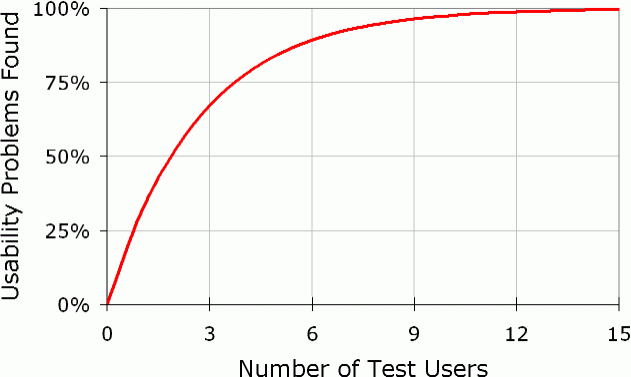Be honest – the phrase ‘usability testing’ doesn’t necessarily sound cheap, does it?
When you hear it, you probably imagine a project land in which outrageous budgets abound, timelines are of no importance – hundreds of users sit in a lab, interacting with the 27th version of a prototype while a design team feverishly takes notes on the subtle and nuanced clicks, head tilts and eye movements of each.
But the reality is much simpler than that.
Because in actual fact, the research on UX research (yes it’s all very meta) has confirmed that you need to test with no more than 5 users to get a reliable and repeatable result.
That’s right. FIVE.
As NNM, the premier authority on UX says:
“After the fifth user, you are wasting your time by observing the same findings repeatedly but not learning much new.”
Why is 5 the magic number for usability testing?
There’s a fair bit of fancy math we could throw your way on this because it’s all about the statistical likelihood of a user encountering an error when testing.
The probability of a user coming across an error is 31%.
Testing with just 5 users then, would highlight at least 85% of the problems in any given interface.
The fancy term for this is ‘binomial probability’.
In essence, with a 31% binomial probability of one user finding an error, once you add more than 5 users to a test group, the ROI of doing so drastically reduces i.e. the more users you add, the less you’ll learn.
All this statistical explanation is to say – elaborate usability tests are a waste of resources, and you can achieve the best results with just 5 users.
Pro tip: Conduct multiple 5 user tests to get the best results
It was back in 2000 that Jakob Nielsen and Tom Landauer found that 5 is the magic number when it comes to user testing.

Source: https://www.nngroup.com/
However, their research does go a little further.
While testing with 5 users will identify 75-99% of all usability problems, you still need at least 15 users to discover all the usability issues with a design.
But the expert advice from here isn’t to always test with 15 users, but instead to conduct multiple rounds of users testing with small groups of 3-5.
Your best bet? 3 design iterations, each tested with 5 different users.
Not only does this save and spread out your budget more efficiently, but it is guaranteed to more optimally improve your design in the long run!
Can you really hack usability testing?
At the end of the day, UX isn’t exactly ‘hackable’, but it definitely doesn’t have to be overblown, expensive and time-sucking.
Done right, UX testing is one of the most informative and useful pieces of a strong, strategic UX design project.
Just ask us – we’re pros at this!
